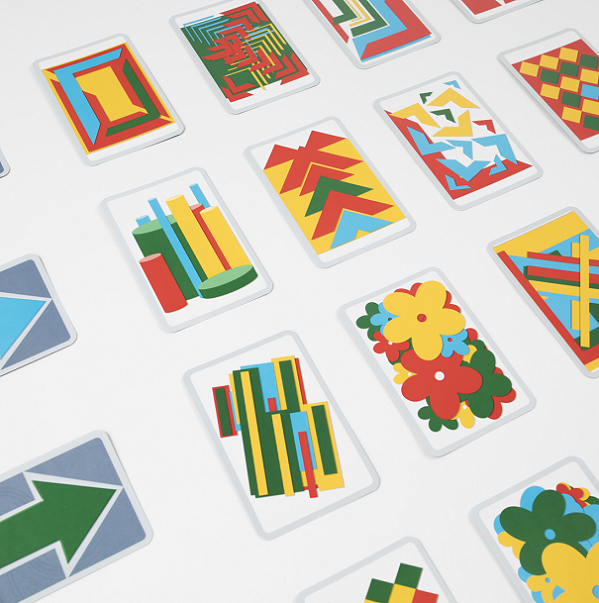Illusion is a Unique Party Game of Color Distribution and Optical Illusions

Is there more red on this card than on that one? It should be an easy question — but it’s not when optical illusions are at play.
Illusion is a party game designed by Wolfgang Warsch (The Mind), in which players attempt to line up cards in order of the amount of specific colors that appear on them. But the addition of optical illusions as a gameplay mechanism is unusual — so how does it work exactly?
Gameplay
Set up the game by shuffling the twelve arrow cards, which come in four colors, and setting them in a stack on the table. You then shuffle the ninety-eight color cards and set them to the side, being careful to keep them face up to the cards’ graphics. Each color card shows a graphic, featuring the four colors in various patterns on one side, and on the flip side the percentage of each color on the card's graphic.
At the start of each round, flip over an arrow card. This says what color is in play that round. You then take the top card of the color deck and place it beside the arrow: this is the row. Players then take turns drawing the next card of the color deck (making sure to never show the percentage side, only the graphic side) and choose where to place it in the row. The goal is to lay out the cards in ascending order so that the card with the lowest percentage of the color shown on the arrow is at the far left of the row, and moves up to the card with the highest percentage on the far right.
On your turn, rather than adding a card, you may choose to challenge the row, saying that you believe that the cards are not in the correct order. When this happens, the cards in the row are all flipped and the percentages checked. If the row was not in the correct order, the player who issued the challenge takes the arrow card. If the row was in the correct order, the player who last added a card to the row takes the arrow card. All the cards in the row are then discarded and a new round begins. Players choose to either play until someone collects three arrow cards and wins the game, or play twelve rounds and declare the player with the most arrows the winner.

Review
Illusion is a light party game that combines its relative ease to teach with some truly unique gameplay. It has very minimal setup time and its basic premise is one that even non-gamers are going to enjoy, as the concept of optical illusions has always been something that captures the imagination of many people.
The artwork on the cards is really varied — when you start comparing them, particularly as more cards come out on the table, it can really start to be tricky to make judgment calls on the color percentages. There’s clearly been a lot of design work put into the graphics of the game.
There is a little bit of an unsatisfactory feeling to the scoring system. Yes, it seems fair that a player who successfully challenges the row wins the point, but when the challenge is incorrect, it feels a bit unfair that only the last player to add a card scores. There’s not really a smooth workaround for this, though, and it almost feels as if some sort of cooperative twist would have worked better. However, Illusion is also very much a game where the fun is in the playing of it and not in the winning. There’s great satisfaction in making a good call, and high expectation in the reveals.
With the right group, Illusion is a lot of fun and quite addictive. We found we wanted to keep going once we got to the end of our first game. There’s also a good bit of replay value packed into it as well, given the number of color cards and the randomization of which ones will come up against which arrows. If you’re looking for a unique party game, Illusion is a good find.
Pros: Unique gameplay, a lot of work has clearly gone into the graphics
Cons: The scoring system feels underwhelming
Disclosure: we received a complimentary review copy of this game.







